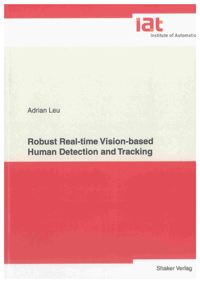
Shop : Details
Shop
Details

September 2014
Adrian Leu
Robust Real-time Vision-based Human Detection and Tracking
In the last couple of decades technology has made its way into our everyday lives including our homes, our offices and the vehicles we use for travelling. Many modern devices interact with humans in a more or less intuitive way and some of them use cameras for observing or interacting with humans. Nevertheless, teaching a machine to detect humans in an image or a video is a very difficult task. There are many aspects that contribute to the complexity of this task, such as the many variations in the humans' perceived appearances: their constitution, their clothes and the dynamic nature of the activities performed by humans.
The focus of this thesis is on the development of reliable algorithms for real-time vision-based human detection and tracking in indoor and outdoor applications. In order to achieve this, the algorithms presented in this thesis were developed for traditional passive cameras, as they perform well in both environments. The novel approaches for vision-based human detection and tracking are presented for three different applications: gait analysis, pedestrian detection and human-robot interaction. These approaches have in common the need for real-time human detection and tracking in video sequences in order to extract application-specific data regarding the tracked human.
In order to cope with human detection and tracking as a computational expensive task, novel hardware-specific optimizations of the proposed image processing algorithms are presented, that allow the algorithms to run in real-time. For this purpose GPU implementations are presented for pedestrian detection and the processing times are compared to CPU and FPGA implementations. In the case of human-robot interaction the real-time human tracking is achieved by using distributed computing.
The focus of this thesis is on the development of reliable algorithms for real-time vision-based human detection and tracking in indoor and outdoor applications. In order to achieve this, the algorithms presented in this thesis were developed for traditional passive cameras, as they perform well in both environments. The novel approaches for vision-based human detection and tracking are presented for three different applications: gait analysis, pedestrian detection and human-robot interaction. These approaches have in common the need for real-time human detection and tracking in video sequences in order to extract application-specific data regarding the tracked human.
In order to cope with human detection and tracking as a computational expensive task, novel hardware-specific optimizations of the proposed image processing algorithms are presented, that allow the algorithms to run in real-time. For this purpose GPU implementations are presented for pedestrian detection and the processing times are compared to CPU and FPGA implementations. In the case of human-robot interaction the real-time human tracking is achieved by using distributed computing.
Keywords: Computer Vision; Human Detection; Human Tracking; Image Segmentation; Disparity Map Segmentation
Publication Series of the Institute of Automation, University of Bremen
Edited by Prof. Dr. Axel Gräser, Bremen
Volume 5.4
Available online documents for this title
DOI 10.2370/9783844030464
You need Adobe Reader, to view these files. Here you will find a little help and information for downloading the PDF files.
Please note that the online documents cannot be printed or edited.
Please also see further information at: Help and Information.
Please also see further information at: Help and Information.
| Document |  | Document | ||
| Type |  | |||
| Costs |  | 36,60 € | ||
| Action |  | Purchase in obligation and download the file | ||
| Document |  | Table of contents | ||
| Type |  | |||
| Costs |  | free | ||
| Action |  | Download the file | ||
User settings for registered online customers (online documents)
You can change your address details here and access documents you have already ordered.
User
Not logged in
Export of bibliographic data
Shaker Verlag GmbH
Am Langen Graben 15a
52353 Düren
Germany
Am Langen Graben 15a
52353 Düren
Germany
Mon. - Thurs. 8:00 a.m. to 4:00 p.m.
Fri. 8:00 a.m. to 3:00 p.m.
Fri. 8:00 a.m. to 3:00 p.m.
Contact us. We will be happy to help you.

